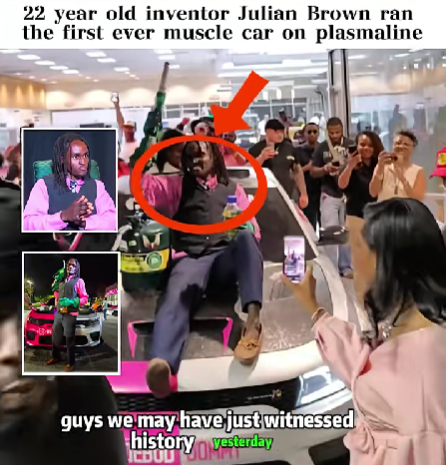The automotive and tech worlds are buzzing after 22-year-old inventor Julian Brown unveiled what experts are calling a potential game-changer — the first-ever muscle car powered by plasmaline, a revolutionary clean-energy fuel that could redefine the future of transportation.
The viral moment took place yesterday at a private automotive showcase in Atlanta, where Brown’s team rolled out a sleek, modified Dodge Challenger. The car roared to life not with gasoline, but with plasmaline — an experimental energy compound Brown has spent the last four years developing in his home lab.
When the engine ignited, the crowd gasped as the car emitted a faint electric hum instead of exhaust fumes. Seconds later, it accelerated across the floor in complete silence — no combustion, no pollution, and no external power source. The audience erupted in applause as Brown climbed onto the hood, arms raised in triumph.
“Guys, we may have just witnessed history,” one spectator said in a viral clip that has now amassed millions of views online.
According to Brown, plasmaline is a synthetic energy fluid that converts plasma reactions into kinetic motion — a concept that combines principles of electromagnetism and chemical propulsion. “It’s like harnessing lightning in liquid form,” he explained during an interview. “The car runs cleaner than electric, faster than gas, and the only emission is pure heat energy.”
Skeptics initially dismissed the idea as science fiction, but engineers who attended the demonstration confirmed that the engine performed exactly as described. “This wasn’t a trick,” said mechanical engineer Laura Hernandez. “The car’s systems have been reconfigured to run on an entirely new type of propulsion source. It’s unprecedented.”
Brown’s invention, reportedly self-funded through scholarships and crowdfunding, has now drawn interest from multiple tech and auto giants. While details remain confidential, insiders suggest that several companies are already competing for partnership rights to develop plasmaline technology at scale.
What makes the achievement even more remarkable is Brown’s background. Raised in a modest neighborhood, he began tinkering with engines at age 10 and taught himself advanced physics using online courses. “I couldn’t afford fancy labs,” he said. “So I built one in my garage. Every failure brought me closer to getting it right.”
Experts are cautiously optimistic but acknowledge that large-scale production and safety testing remain major hurdles. “If plasmaline proves stable, it could disrupt everything from cars to aerospace,” said Dr. Rafi Malik, an energy researcher at MIT. “But we need years of data before we can call it commercially viable.”
Meanwhile, the internet has embraced Brown as a symbol of innovation and youthful brilliance. Hashtags like #PlasmalinePower and #JulianBrownEffect are trending worldwide, and fans are already calling him “the next Elon Musk.”
When asked what comes next, Brown smiled modestly and said, “This isn’t just about cars. It’s about showing young people that impossible ideas are worth chasing. The world runs on limits — I just want to rewrite them.”
If his breakthrough holds up under scrutiny, Julian Brown may have just ignited the spark that powers the next era of human innovation.
